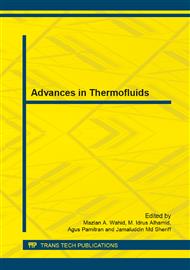p.18
p.23
p.29
p.34
p.40
p.47
p.52
p.58
p.63
Performance of Thermoacoustic-Standing Wave as a Power Generator
Abstract:
This study is relating to analyze performance of thermoacoustic-standing wave. Stirling cycle thermoacoustic engine is developed conventional stirling engine. This system is more efficient than ordinary stirling engine because does not use a moving piston[7]. The engine uses thermal power to generate acoustic power. It consists mainly of three parts: a thermodynamic part consisting of a stack, two heat exchangers, and a thermal buffer tube; an acoustic network consisting of an acoustic compliance and an inertance; and a resonator. When thermodynamic part heated, it will generate sounds. The sounds will flow along cylinder tube. Some aspects can be analiyzed to determine performance of tharmoacoustic-standing wave. The effect of temperature difference, stack geometry, stack position determine performance of the thermoacoustic-standing wave. Some research show that acoustic power will increase with increasing of temperature at hot heat exchanger. And optimal position and geometry of stack will generated optimal acoustic power.
Info:
Periodical:
Pages:
40-46
Citation:
Online since:
August 2013
Authors:
Keywords:
Price:
Сopyright:
© 2013 Trans Tech Publications Ltd. All Rights Reserved
Share:
Citation:


